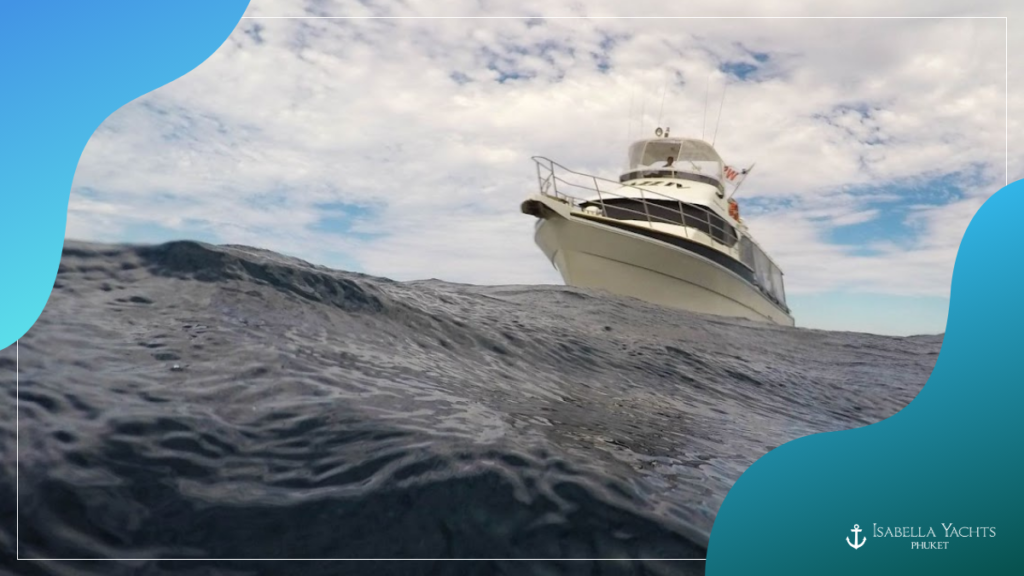
None of us particularly enjoys sailing in bad weather, but if you venture far enough offshore, you’ll have to do it eventually. No one is safe from severe weather unless they have fifty feet or more of fiberglass beneath them. Being well-prepared is the key to a successful voyage through rough seas. Make sure you and the crew have had enough time to refuel before the storm hits. We’ll trust that you have a competent team aboard and that they have had sufficient rest and training before the journey.
In this article, we will be taking a look at how to prepare for sailing on rough seas when you’re on a yacht charter to ensure you, the crew, and the captain are safe.
Can a luxury charter yacht survive rough seas?
Many individuals desire the luxuries a yacht provides, but they question if the vessel can withstand stormy seas and hurricanes. This is a fair question, as many yacht owners may like to traverse oceans or hop between islands during hurricane season. The short response is ‘yes,’ but this may not alleviate the underlying problem of what it takes to damage a yacht to the point where the crew and passengers are in danger, and a deeper examination of the matter is required.
Some yachts are designed to resist extreme weather and sea conditions. However, a yacht needs to be better equipped to deal with hurricanes. They may survive them at sea, but it is not their purpose to do so. Other yachts are not designed to weather heavy seas or severe storms, so be sure to be careful no matter what yacht you’re riding in.
How to prepare a yacht for sailing in heavy storm conditions
Being vulnerable to extreme storms at sea causes anxiety and uncertainty, dampens morale, and results in poor decision-making. This is when properly prepping the boat and having a clear, well-thought-out strategy enables you to go through the storm without requiring superhuman power, ability, and endurance. Yachts with a capable captain and crew can withstand the majority of adverse weather conditions without damage. However, in the case that you need to weather through a storm, we have listed down a list of things you can do to properly prepare to face it:

1. Allot time to make the necessary preparations
Preparation is the name of the game when it comes to sailboats, whether it’s changing the impeller before it fails or coiling lines properly before departure. Keep everything that can be moved in the cabin and out of it in locked (closed) storage. If not, make sure to secure your gear, so it doesn’t fall and cause any harm. If you haven’t already, this is an excellent time to inspect the euro rigging and repair any damaged or worn parts. Inspect the sails as well. Keeping everything in working order and adequately maintained is a full-time job, and if you don’t put in the effort to maintain your yacht, it will fail you when you need it the most.
2. Wearing the right type of clothing
When precipitation is abundant, the air temperature drops, but the humidity rises. As a result, you’ll need to pack a very warm outfit, as well as one that’s water-repellent, to ensure you don’t freeze to death. When your yacht enters into the storm, it’s too late to change into the right clothes. Be sure to have everyone on board wear life vests and safety harnesses. Being on deck can be challenging; ensure that the inexperienced, especially children, are kept safe, dry, and comfortable.
3. Ensure your yacht stays dry
Close any deck or interior hatches to keep water out of your boat. Keep the saloon dry by closing the companionway. If your ship has a deckhouse, you should keep in mind that the top should be raised.
4. Keep note of the nearby ports
Locate a safe harbor to see if you can take shelter from the storm. It’s best to avoid attempting to dock your yacht when the winds are blowing hard from offshore. However, a sizable, protected harbor may be accessible before things get too serious. Keep a note of the location of all these ports and harbors cause they may save you once things start getting out of control.
5. Prepare your crew for the probability of a mishap
One can never be too cautious, but it is preferable to anticipate a mishap in the water while entering a storm, particularly while sailing with non-aquarists. In a panic, even the most seasoned sailors might lose their composure. Review man overboard and euro capsize procedures if you’ll be sailing in a dinghy, so everyone on board will be prepared for any emergency.
Bottom Line
Yachts can withstand severe weather conditions such as tropical storms and hurricanes. However, you should not test your luck by venturing out on the water during these incidents. Whenever feasible, it is always ideal to avoid any harsh weather in order to keep you, your yacht, and your crew safe from it. Usually, the best course of action is to sail away from the storm or to enter a safe harbor. Keep in mind that your safety should always be your number one priority!
If you are looking for a yacht charter in Phuket that knows how to deal with rough storms and unpredictable waves, then Isabella Yachts is the team you need! Isabella Yachts was established in 2012 on the Thai island of Phuket, and it provides crewed and bareboat charters for trips to the islands of Thailand and Myanmar. We have more than 10 year-round staff members based in Phuket, so we can help you whenever needed. Aside from English, our staff is fluent in Thai, Italian, Spanish, and French. We want to ensure you have a great time sailing through the waves of Phuket!